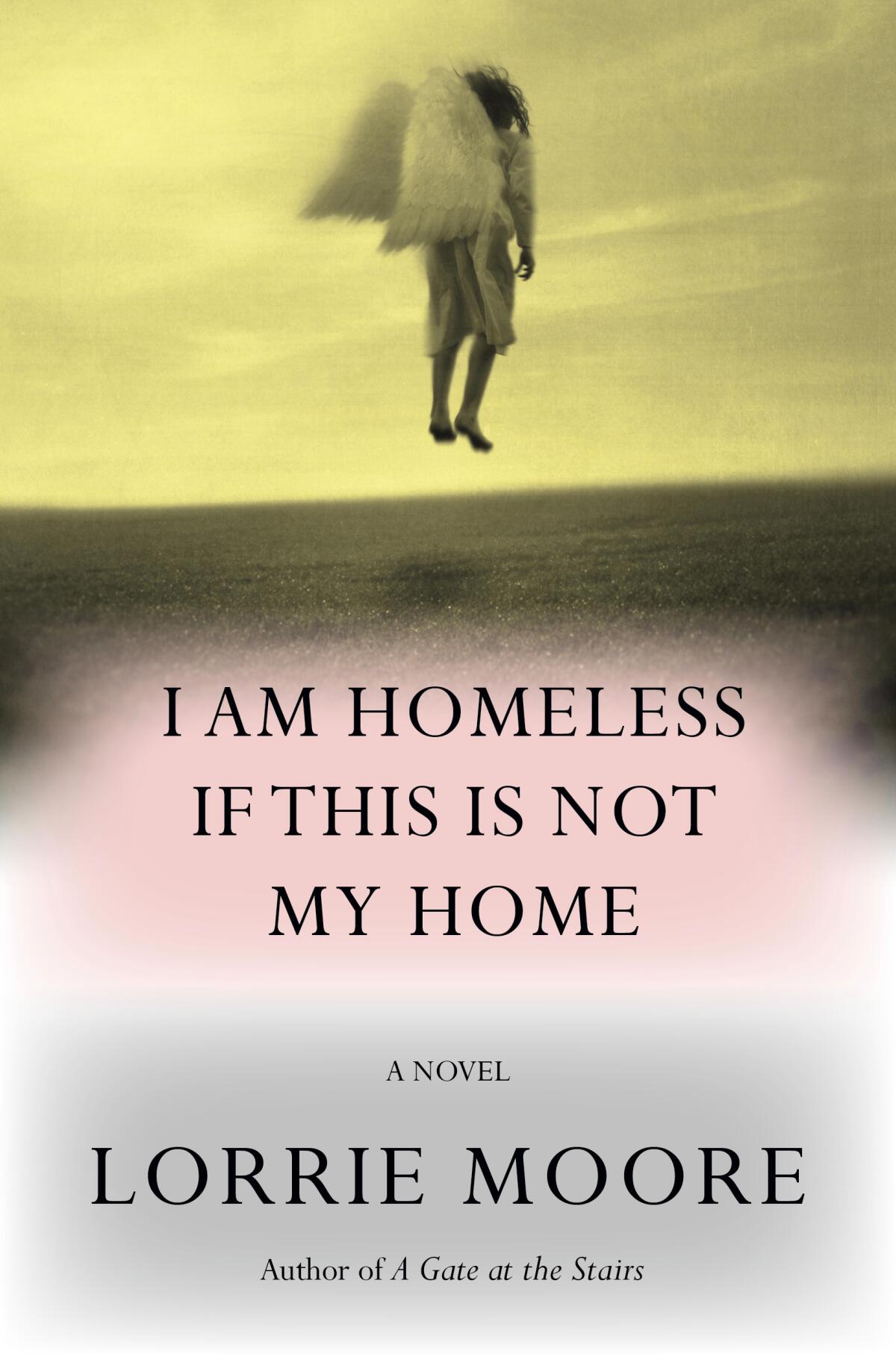In Lorrie Moore’s first novel in 14 years, 2016’s chaos becomes a wild metaphysical trip

- Share via
Review
I Am Homeless if This Is Not My Home
By Lorrie Moore
Knopf: 208 pages, $27
If you buy books linked on our site, The Times may earn a commission from Bookshop.org, whose fees support independent bookstores.
Lorrie Moore’s fourth novel, “I Am Homeless if This Is Not My Home,” is, as Winston Churchill once observed of the Soviet Union, a riddle wrapped in a mystery inside an enigma. I wouldn’t have it any other way. Mostly centered on a middle-aged high school teacher named Finn who is navigating both the impending death of his older brother and a more elusive sort of loss involving his ex-girlfriend Lily, the book comes billed as a ghost story, but that isn’t exactly right. Rather, it is novel as metaphysical meditation. “Death was a sea,” Moore writes in the early pages, “and Life was another sea.” Those capital letters are as instructive as they are intentional, one of the many ways the novel teaches us how it means to be read.
My favorite reading experiences are those where I arrive knowing nothing, without preconceptions of any kind. In a certain sense, that has happened here. I’ve long admired Moore’s work, especially the collections “Birds of America” and “Bark.” (Her story “People Like That Are the Only People Here,” about a mother confronting a 1-year-old’s cancer diagnosis, may be the most ruthless piece of fiction I know.) Still, I avoided any advance notice of this book. I didn’t even read the cover flaps. A part of me wants to recommend the same approach, but then you wouldn’t be reading this review. And so, here we are.
Domestic life motivates many of the stories in ‘Bark,’ Lorrie Moore’s first fiction collection in 15 years.
That is one of the points of “I Am Homeless if This Is Not My Home”: that wherever you go, there you are. Every character in the book is dealing with events they can’t foresee or foreseeable events they can’t forestall — not least because the world appears to be falling apart.

It’s the fall of 2016 and Finn’s brother, Max, is in hospice in the Bronx. Finn is nothing if not lost. The country itself is about to face a terrible reckoning. The Chicago Cubs are in the World Series for the first time since 1945, but there’s not even solace in that. The brothers, despite being from Illinois, are unsure which team to root for; “I kind of want Cleveland,” Finn admits, to which Max responds, “Oh, come on, no, you want Cleveland? I kind of want Cleveland too.” The Series is just one emblem of a larger state of disunion. The defining ethos of the year, Moore insists, is flipping the finger in various directions: “politicians to their parties, voters to the candidates, candidates back to the people, Stockholm to novelists, Bob Dylan to Stockholm. All that was left was the Cubs and the Indians.”
This too is where we are.
Moore complicates the timeline by interweaving another narrative, told via a series of letters written by an innkeeper to her sister just after the end of the Civil War. The inn sits on South Sunken Road, which played a key role in the Battle of Antietam, where nearly 23,000 died or were wounded on the most death-drenched day in United States history. Moore takes her time in making the connection between then and now explicit; among the abiding pleasures of her new novel is the extent to which it requires us to read between the lines.
“A Dangerous Business,” the latest novel by Pulitzer Prize winner Jane Smiley, follows a brothel worker in Monterey investigating disappearances.
The innkeeper, for instance, is infatuated with a guest named Jack, an actor who may also be a fugitive; he claims to have pensions from both the Confederate and Union armies. When, after death, his identity is uncovered (I will not share it here), it comes as the best kind of surprise: inevitable if also unexpected, like a key turning in a lock. Yet even here, Moore seeks to confound us.
“Perhaps Jack the boarder had seeded his own rumors,” the innkeeper observes. “I did not know whether he had the right eye color for who they all thought he was, but that would be no problem if I could stick the eyes shut with goat glue.” The implication is that identity is flexible, easily adjusted to fit the necessities of narrative. Such a narrative may be written or it may be spoken. It may appear in a letter or a book. Either way, it matters less who Jack is than what he represents.
A similar conditionality infuses Finn’s story, which becomes progressively stranger as the book goes on. Here too I don’t want to reveal too much, except to say he spends much of the novel on a dreamlike road trip, accompanied by the aforementioned Lily, who appears to exist in a version of the bardo — a nether region between life and death. Imagine if Addie Bundren were awake and talking throughout William Faulkner’s “As I Lay Dying.” (Moore cites the book in one of her epigraphs.) “Death was a sea and Life was another sea”: This may be the most illuminating statement in the narrative.
The metaphysics are not always consistent. Is Lily alive or a hallucination? If the latter, how can she be seen by anyone but Finn? By the same token, the geography of the novel occasionally slips a little, especially once the narrative shifts to the south.
The most anticipated fiction books of the summer includes new works from Lorrie Moore, Colson Whitehead, Ivy Pochoda, Tom Rachman and other great stylists.
But here’s the thing: I don’t care about that. I’m reading not for the tightness of the structure but for the acuity of the reverie. Moore is after something more mysterious than naturalism. She is operating in the territory of myth. “It was all hopeless,” Finn reflects of Lily late in the novel: “like Eurydice, she’d grown fonder of the underworld. … Or perhaps she was not Eurydice but just some irrelevant lovely bug, something with the skitter of a beetle, the group-kamikaze of an ant, the horned ass of an earwig. Human pleas were useless. He felt a little desperate and overwhelmed.”
Eurydice or some irrelevant lovely bug — what’s the difference, in the end? “In life’s wrestle with death,” Moore declares, “there was much suffering, and in death a diabolical vanishing. Did everyone understand that’s what they had signed up for, or really just not signed up at all but been drafted? Life was soldiering. Death was disappearance. Death sure had the power move.” And yet, it’s precisely this that makes Moore’s fever dream of a world feel so relentlessly real.
Ulin is a former book editor and book critic of The Times.
More to Read
Sign up for our Book Club newsletter
Get the latest news, events and more from the Los Angeles Times Book Club, and help us get L.A. reading and talking.
You may occasionally receive promotional content from the Los Angeles Times.












